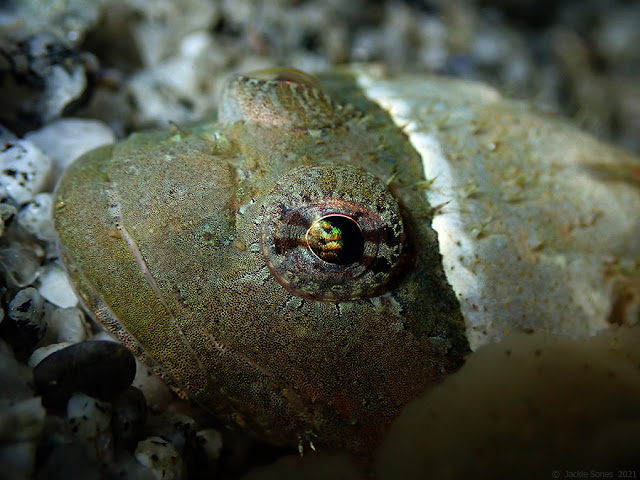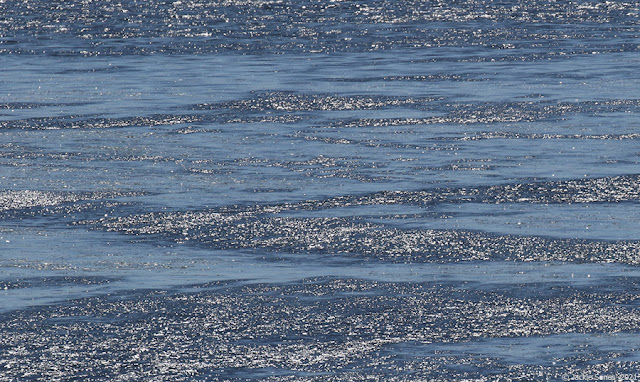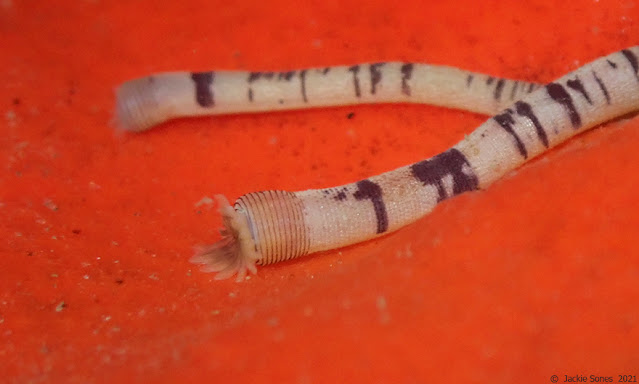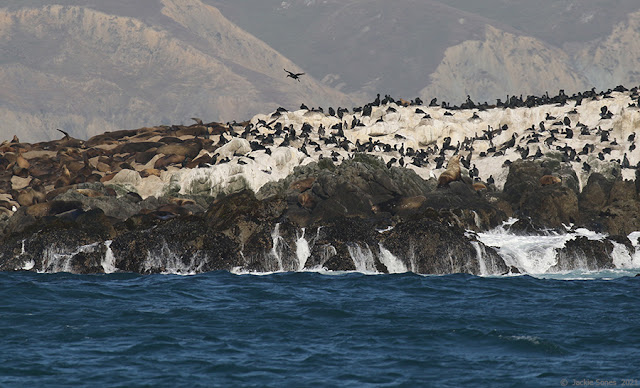We've been working down in Santa Barbara County for a couple of days, heading back north soon. Here's a nice coastal view after we finished field work on 28 June 2021.
Tuesday, June 29, 2021
Afternoon view
Monday, June 28, 2021
Coastal colors
Friday, June 25, 2021
Gold!
Well, I think Eric took home today's prize for the prettiest intertidal zone photo. He found a beautiful cluster of kamptozoans (Barentsia conferta) living at the base of some coralline algae. It's an amazing field photo of some tiny animals — each of the crowns (with the tentacles) in the photo above is only ~1 mm or less across.
To learn a little more about kamptozoans, you can review these posts: "Tiny crowns" on 22 May 2020 and "Nodding heads" on 8 July 2012.
Nicely done, Eric!
Thursday, June 24, 2021
Breach!
I know, it's a bit distant and blurry, but there were some nice Humpback Whale (Megaptera novaeangliae) breaches out near the horizon today off Bodega Head. Some full body breaches (with giant splashes), some flipper-slapping, some lob-tailing, some spouts, fins, and flukes. A little bit of everything! So here's one photo for the record on 24 June 2021.
Wednesday, June 23, 2021
Tuesday, June 22, 2021
Catch of the day
I was working at my desk when Eric came by to let me know there was a whale close to shore. I went out to see if it was still there and didn't see it, but something else caught the corner of my eye while scanning for signs of the whale. It was strange — I didn't immediately have an idea about what I was seeing. From a distance it looked like a piece of driftwood, but it appeared to be swimming, so I kept watching as it approached the shore. Here's my first view with the zoom lens:
Monday, June 21, 2021
Beetle time
Earlier in June, I looked down to see this interesting beetle starting to explore my watch! I suppose you can't tell how large my watch is, but it's still somewhat helpful for scale. [The watch is about 3 cm (~1 inch) across.]
I think this is a Coyote Brush Leaf Beetle (Trirhabda flavolimbata). Check out the beautiful metallic green color on the wing covers:
Sunday, June 20, 2021
Bigfoot sighting?
Juvenile California Quail (Callipepla californica), photographed 11 June 2021. I was impressed with the size of its feet!
P.S. Happy Summer Solstice!
Friday, June 18, 2021
Riding thermals
I stepped out of my car this morning (18 June 2021) to see this Peregrine Falcon (Falco peregrinus) riding thermals with vultures over the Bodega Dunes.
Wednesday, June 16, 2021
Peanut brittle?
Okay, I know I've shown a few peanut worms recently, but this was a nice view of several different peanut worms (Phascolosoma agassizii) extending their introverts from a crevice and using the short ring of tentacles at the end to feed. You can also see several arms of a brittle star extending out of the crevice and even lying across one of the peanut worms.
P.S. If you want to play the "phyla game" again, look around to see what you can find. Below I'll list the phyla in this image.
1. Peanut worm (Phascolosoma agassizii), Phylum Sipuncula
2. Brittle star, Phylum Echinodermata
3. Barnacle, Phylum Arthropoda
4. Limpet (checkered, in lower left corner), Phylum Mollusca
5. Tube worm (orange tentacles, upper right corner), Phylum Annelida
6. Flatworm (gray/white, same species as last night), Phylum Platyhelminthes
Tuesday, June 15, 2021
Local diversity
Eric noticed a beautiful scene in the low intertidal zone a few days ago. There are six (!) different phyla (major animal groups) represented in this image, all in an area that was only ~4 cm x 4 cm (or ~1.5" x 1.5").
Feel free to look around and see what you can find.
In the next image, I've circled or pointed to representatives of each phylum.
Green arrow = sea anemone (Epiactis handi), Phylum Cnidaria
White circle = barnacle (Chthamalus dalli), Phylum Arthropoda
Blue circles = flatworms (unidentified), Phylum Platyhelminthes
Orange arrow = peanut worm (Themiste pyroides), Phylum Sipuncula
Purple oval = tubeworm tentacles (Phragmatopoma californica), Phylum Annelida
Pink arrow = chiton (Tonicella lokii), Phylum Mollusca
Monday, June 14, 2021
Seeing eye to eye?
This wonderful sculpin was peeking out from behind a large sea anemone. At first I wasn't sure about taking a photo because I couldn't see the entire fish. But then I crouched down and looked more closely at its eye and the markings on its face, and I gave it a try. I'm glad I did! Check out this close-up:
Sunday, June 13, 2021
Little Henry
Eric's sharp eyes spotted this juvenile Dwarf Mottled Henricia (Henricia pumila) yesterday, 12 June 2021. We were excited to see it because this species of sea star has been absent from Bodega Head (local populations were likely impacted by a harmful algal bloom back in 2011). [We've observed Henricia at sites to the north and south, but not in Sonoma County in quite a few years.] This individual was only ~5-7 mm across. We hope there are more out there!
P.S. Our nickname for Henricia is "Henry," hence the title of this post.
Saturday, June 12, 2021
A van Gogh or a galaxy?
A close-up of the girdle or margin of a Woody Chiton (Mopalia lignosa), photographed on 12 June 2021. In the field, Eric noticed the amazing colors and patterns, especially the different shades of blue. It reminded him of a celestial sky in a van Gogh painting, while it made me think of looking out at a galaxy:
Friday, June 11, 2021
Bound together
Thursday, June 10, 2021
Wednesday, June 9, 2021
Calming effect
The wind picked up this afternoon (9 June 2021), but it remained calm among the Eelgrass (Zostera marina) in Bodega Harbor.
Monday, June 7, 2021
Iridescence in the air?
I don't know much about clouds, but there were some wild ones overhead around noontime today (7 June 2021). We could see a distinct band of clouds passing by with long wispy strands extending to the south.
Eric looked up and said something about a rainbow, and I was confused at first, but then focused on where he was looking and saw subtle colors in the clouds:
It was hard for me to capture this, but here are a few examples to document it. These were very high, thin clouds, less than 45° from the sun. The colors did not appear to be in "rainbow order," and instead appeared more random. As the distance between the clouds and the sun grew, the colors faded.
Sunday, June 6, 2021
Beach denizens
Eric and I made a quick trip out to the outer beach on Point Reyes yesterday (5 June 2021). A few fun beach invertebrate highlights included this Red-backed Jumping Spider (Phidippus johnsoni) hanging out in a large piece of driftwood (above), a nice look at some Western Tiger Beetles (Cicindela oregona) along the upper beach near a freshwater seep :
Saturday, June 5, 2021
A clean sweep
Such a cool view of a peanut worm (Phascolosoma agassizii) collecting food particles off the surface of a sponge. The peanut worm in the foreground has its tentacles extended and is sweeping them backwards (to the right) as it retracts its trunk-like introvert.
We've seen this behavior so often now that we're wondering if it's mutualistic — e.g., does the sponge benefit from having its outer surface "cleaned" of large particles and does the peanut worm benefit from having a smooth surface from which to collect food?
Friday, June 4, 2021
Dark star?
Moonglow Anemone (Anthopleura artemisia) photographed in a tidepool on 29 May 2021.
And a slightly closer view, too, so you can appreciate the colors and patterning:
Thursday, June 3, 2021
Almost invisible
I had to do some work in Bodega Harbor on Monday (31 May 2021), but on the side I noticed some small (~3 cm long) flatfish among the eelgrass and sea lettuce. Not sure which species this is, but maybe someone will be able to help out with an identification?
P.S. Can you see the black and gold coloration? I can't help it — have to give a shout out to the Boston Bruins! Go B's! :)
Tuesday, June 1, 2021
Passing by Bodega Rock
To end this edition of pelagic week, a couple of photos of Bodega Rock as we made our way back in to Bodega Harbor on 23 May 2021.









































